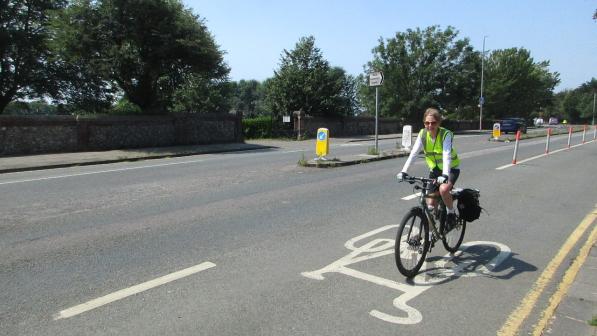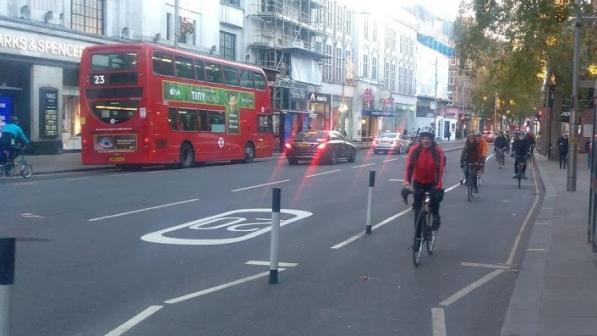Cycle lanes move more people in less space

Last week, I logged on to watch Cycling UK’s policy director Roger Geffen give evidence to the Transport Select Committee’s inquiry on reforming public transport after the pandemic. Roger was about to spill the beans about a suppressed report outlining the money needed for the Government to reach its target to double levels of cycling in England by 2025, urging the committee to press ministers to release it.
Frustratingly, however, questions to witness quickly turned to whether or not schemes introduced over the last year to enable more people to walk and cycle had created more congestion. I say 'frustratingly' because the contention that cycle lanes cause congestion is never supported by evidence, merely by anecdote and perception, which those arguing the case for active travel infrastructure are then expected to disprove with evidence.
Evidence and anecdote
Ironically, just as members of the committee were asserting that we seemed to have created more congestion in urban areas, the annual INRIX report landed in my inbox.
Whenever I quote the results of surveys or research there’s usually a sceptic who says it’s a Cycling UK survey, it’s a biased report, we only spoke to cyclists, or that we would say that wouldn’t we?
It’s difficult to claim that, however, about INRIX, a global data analysis company specialising in traffic data, which publishes an annual scorecard crunching the numbers on congestion, hours lost in traffic and the cost of congestion.
Just looking at headline data, the latest INRIX scorecard shows us that in 2020:
- UK city centre congestion was down 52%
- Although drivers in London still lost 69 hours a year to traffic congestion, that was 53% less than in 2019
- Across the UK, drivers spent 68% less time to traffic congestion
Translating all of that into money, INRIX calculate the economic savings over the year of this reduction in congestion at:
- £613 for each driver
- £3.4 billion across the UK
In the case of cycle lanes, those who have decided they increase congestion are often reluctant to accept evidence to the contrary, and their response to data at a city-wide or national scale is that congestion can be hyper local, with active travel infrastructure creating local congestion.
But the INRIX scorecard also has some more granular detail, looking for example at the worst congested corridors within cities, which unsurprisingly all saw dramatic decreases in delays compared to 2019.
Slaying the myths
Of course, the argument that cycle lanes cause chaos isn’t new, though the introduction of more temporary active travel schemes last year did increase the level of bikelash amidst inaccurate claims that empty cycle lanes were causing gridlock.
That’s why we took these claims to the experts, who looked at evidence rather that rhetoric and resoundly concluded that bike lanes were best and the bikelash, largely baloney.
Moving more people in less space
Turning the narrative round to reasons for cycle lanes rather than myths to oppose them, we also looked specifically at the evidence that clearly shows they move more people in less space, and reduce congestion.
If you’d arrived in the UK for the first time last summer and read or listened to media reports, you might have assumed that before temporary cycle lanes were installed in response to coronavirus, cars and other vehicles flowed freely through and between our towns and cities, and that we’re all experiencing traffic congestion and delays for the first time!
Back to reality, the truth is that pre-coronavirus, in 2019, congestion cost the UK economy £6.9 billion, with UK road users on average loosing 115 hours and £894 a year to congestion.
But even though statistics for the previous year, 2019, show that motor traffic on minor urban roads (residential areas) increased by 36.4% in 15 years, with miles travelled by car and vehicle registration numbers still increasing annually, some still cling on to the myth that cycle lanes cause congestion. They insist that road space is being taken away and given to cyclists, but questions about road space can be misleading, because the more important question is how many people can be moved in the space?
70% of the people in 20% of the space
For example, on London’s Blackfriars Bridge, the cycle lanes take up 20% of the road space, but 70% of the people crossing the bridge at peak times do so within those lanes.
That’s because a three-metre wide lane can move 700 to 1,100 people per hour in cars, but if used by people cycling or walking, that increases to 2,000 to 6,500, and it’s why, two weeks after opening, the cycle superhighway corridors in London were moving 5% more people per hour than they could without cycle lanes.
Of course, if a cycle lane is installed today it might not be full tomorrow, because behaviour change takes more than a day. But where good quality cycle lanes are built, people use them and those lanes move more people more efficiently in less space, enabling some to switch from using their cars, reducing the number of cars in the main carriageway.
Congestion in much of the UK has been increasing every year due to the inefficient use of road space caused by too many cars carrying one or two people. Building cycle lanes to enable more people to replace some car journeys by active travel is the solution to congestion, not the cause.
Inconvenient facts and evidence
Nevertheless, and despite all the evidence to the contrary, spurious congestion claims are often the first shots fired when bikelash begins, a classic example being the cycle lane along Upper Shoreham Road in Shoreham, the removal of which Cycling UK is challenging in court through judicial review.
Residents' claims that installation of the cycle lane either would or did cause congestion were bogus, with the council officer’s technical report showing that following installation of the lane that average drive through times remained the same, with no increase in congestion.
But evidence and facts can be an inconvenience when you’ve already made up your mind, so even though the report also confirmed that there was no increase in air pollution following installation, that the emergency services had no concerns (objections two, and three in the cycle lane objector’s handbook), and that the lane was well used by people cycling receiving high numbers of positive comments, the council still removed it.
One of the reasons Cycling UK is challenging this decision is that we believe decisions made about active travel infrastructure, including its removal, should involve some rational consideration of evidence and data, looked at in the context of the applicable statutory guidance.
Our frequently asked questions contains more information about the case and why we’re doing this, but we can only pursue cases like this with your support for our Cyclists’ Defence Fund, so please contribute if you want us to keep fighting not just for people who already cycle, but those who can’t or won’t - but might, if councils like West Sussex didn’t make irrational decisions.
Donate to the Cyclists' Defence Fund
A more positive vision – cycling for everyone
To combat this negativity around cycle lanes and interventions to enable more people to walk and cycle, our Election 2021 campaigns are going to focus on the undeniable benefits of getting more people cycling, and what both national and local governments need to move up the gears to ensure that cycling is for everyone: our 2021 campaign message.
We’ve yet to launch the England local election campaign but watch this page for news.
Our campaigns are, however, already live in Scotland and in Wales with both Welsh and Scottish manifestos calling for the next governments to spend at least 10% of the transport budget on active travel.
If you live in Wales and agree, please show your support by signing our petition calling on political parties to include commitments in their manifestos to:
- Invest, spend more money on infrastructure and behaviour change
- Deliver, make it happen by creating high quality cycle lanes and liveable neighbourhoods.
- Do it across Wales, connecting communities across Wales with each other and the countryside.
Take action for cycling in Wales
You can also sign up for our online active travel hustings on the evening of 23 March.
If you live in Scotland, you can do the same by signing our petition calling on political parties to include commitments in their manifestos to:
- Invest more money in cycling
- Create safe space for people to cycle, walk and wheel
- Enable people in rural communities to cycle



